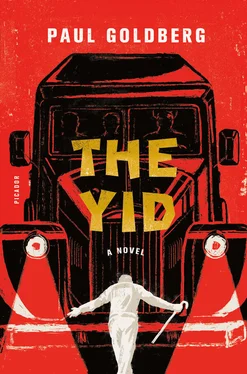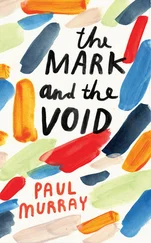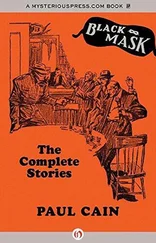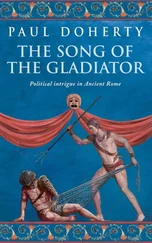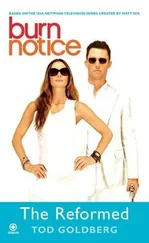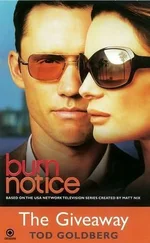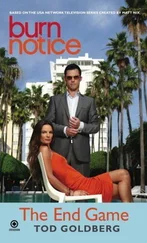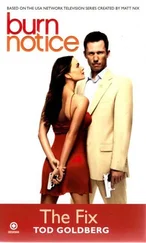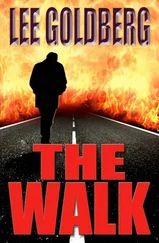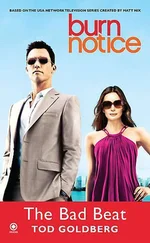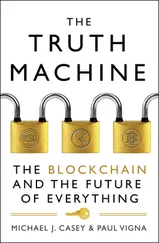Now Lewis cannot stop.
“I think I know what was in that syringe of Esther’s: the fatty, brown brew that bubbled in Levinson’s cauldron. Kima, when Levinson turned out the light to make it easier for the suddenly squeamish Kogan to slit Stalin’s throat or stick him like a pig, somebody injected that concoction — that brown sauce mit shkvarkes —into the catheter, and into Stalin’s veins.
“Contaminated, broken-down blood and lard would trigger an allergic reaction that people who don’t know better would mistake for a stroke, especially when the patient is found in a coma half a day later. The czar is stung. The rest is simple: sepsis, Cheyne-Stokes respiration, and … kaput. You killed him, Kima.”
“ Dumay chto khochesh,” she blurts out finally. Think what you want.
She turns around, as though getting ready for a return journey.
“I think I know why Kogan sabotaged the play.”
This makes her stop.
“Why do you think?”
She stands by Kogan’s tombstone, her fury gone.
LEWIS: I think he did this to let you kill the tyrant who stole your childhood. This was his gift to you: a secret place in history, his treatment for an icy orphan. He gave you life through Stalin’s death, and in the process, you saved the lives of millions of Jews whose names were on the lists.
KIMA: What do you want from me?
LEWIS: You stopped the trains. You saved your people. You may have saved all mankind. What more could anyone want? The Book of Esther describes a smaller feat.
KIMA: Ah, Esther! What was her life like after that thing in Shushan?
LEWIS: I never thought of that. I don’t know.
KIMA: I breathe, I teach, I write a little. I live a life I never thought I’d have.
LEWIS: One of us died during that raid. And ten on their side — two by your hands.
KIMA: I think of Kogan, and Levinson, and Ol’ga Fyodorovna. She called me dorogusha after that night. I buried them one by one, and then I left. I think of fierce Rabinovich, and you, of course.
But no regrets, no blood-bathed boys, no ghostly visitations. This city lives, the Earth is turning, and we are on it still. Five years ago, I found a way to mark this day. I took my grandsons to the beach and watched them play. We are not … What’s that word?
LEWIS: Farflokhtn.
Though I was born six years after Stalin’s death, I have multiple connections to this story.
I owe much to my father, Boris Goldberg, a journalist and a poet. In mid-August 1959, in Malakhovka, he took me across the street to meet the man who translated King Lear into Yiddish. Shmuel Halkin had returned from the camps a sick man. An entry in my father’s diary describes this meeting in considerable detail. Knowing that the author of Kinig Lir and I literally, physically intersected on this earth established a powerful link to these fantastic events.
My grandfather — Moisey Semyonovich Rabinovich — provided another link. He told war stories, both real and imagined. In reality, he was an artilleryman in the Civil War and a pharmacist at front-line hospitals during World War II. The fantasies he created for my benefit made him a partisan and a commando. I remember those stories well. In many ways, this novel is an homage to his storytelling. The “fierce Rabinovich” in this book is based on the fictional character he created.
Thanks to my grandfather, I met many men like him, war heroes — old men by the time our paths crossed. Carrying rolled-up copies of Krasnaya Zvezda , the Red Army newspaper, in their pockets, they traded war stories in Russian and Yiddish. I listened.
A leap of fiction brings with it the privilege to blend history with fantasy. I am intimately familiar with Levinson’s communal flat in the center of Moscow. I spent the first twelve years of my life there. I let Levinson have the room which in reality my parents and I shared. While Levinson didn’t live in that apartment, two of the characters — the aforementioned Moisey Semyonovich Rabinovich, who, in fact, was the manager of Drugstore Number Twelve, and Ol’ga Fyodorovna Zabranskaya — indeed lived there.
Ol’ga Fyodorovna was a proper elderly lady who befriended my mother, and I have repaid her kindness by making her a heroine of this story. A few of the trinkets Ol’ga Fyodorovna gave my mother are in my house in Washington.
The Malakhovka dacha where bodies are dumped — Zapadnaya Number Four — belonged to my grandmother.
The idea for this novel came to me when I was around ten.
German Grigoryevich Pervov, the father of my friend Alyoshka Pervov, pointed to an apartment building entryway at Chaplygin Street and said: “This is where in 1944 they arrested a Jewess for killing a Russian girl and putting her blood in the matzos.” Then he described watching this woman’s arrest. I returned home — a few blocks away — and told my parents, who then told me about anti-Semitic mythology.
This evil myth shook me to the core. Of course, I believe that some hapless woman was led away in handcuffs. I can accept the notion that she had committed murder (such things happen). The exact address is 15 Chaplygin Street. If anyone knows what actually occurred, I urge you to find a way to get in touch with me or a journalist of your choice. I would consider it an honor to unite this woman with her true story. Many of my colleagues would, too. More than anything, that distant event gave me the appreciation of the power of an urban legend.
My aunt Ulyana Iosifovna Dobrushina, who grew up in an illustrious Jewish theater family, told me about her encounters with Solomon Mikhoels, the giant in the background of this novel. She gave me books about the Moscow State Jewish Theater. GOSET was one of the great theaters of Europe, and my aunt was a link to its glory.
I didn’t invent Levinson. I took him from the pages of Aleksandr Fadeyev’s Soviet classic novella Razgrom— translation: Defeat —which takes place in the Ural hills during the civil war. In these pages, I give Levinson a different first name and imagine his later life. I imagine him as an inflexible autodidact who stumbles into theater. A sad clown. Conveniently, I let him keep the sword that belonged to his prototype. I didn’t invent Commissar Yefim Zeitlin, either. He was a cousin of my grandfather’s, and one of the founders of the Comintern for Youth, known under the acronym KIM. Yefim was executed circa 1938. His daughter Kima is entirely fictional. I have no idea whether Yefim was ever a member of the Jewish Bund, or for that matter a Bund sympathizer. He is now.
I could never have made up Kent and Tarzan, the two thugs in this book. Fortunately, I didn’t have to. As a young reporter, my father traveled to a penal colony for young criminals and interviewed some of the boys there. Though the book he wrote was never published, a draft survived emigration, and I used it to breathe life into Kent and Tarzan. The name Kent really did exist in the Soviet underworld, as did the verb skentovatsya , to bekent (or, better, conkent).
My daughter Katherine Pavlovna Goldberg, now a costume designer for stage and screen, walked me through history of theater and the intricacies (and perils) of method acting. Without her brilliant notes — given to me on a memorable hike in Vermont — this book would have fallen flat. My daughter Sarah Pavlovna Goldberg, a gifted young writer who, on the threshold of going to college, seems to gravitate to comedy, inspired some of the more irreverent lines.
Many of my friends enriched this narrative. Lyudmila Alexeyeva, who as a septa- and octogenarian became the leader of opposition to Putin’s regime, helped me re-experience my country, its culture, and its democratic tradition. Lyuda is a teacher, a coauthor, and a friend. She was there, in 1953, struggling with profound doubts. Of course, I was full of admiration for the democratic, “Westernizer” wing of the Russian intelligentsia. I met Lyuda during her immigration period in the United States. Thanks to our collaboration, I gained insight into our common roots.
Читать дальше
